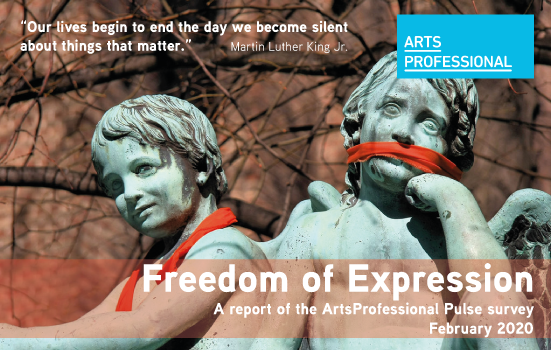
This ArtsProfessional survey has gathered evidence about the pressures to self-censor that artists and arts professionals experience in their working lives, and the ways in which they feel their freedom of expression is curtailed.
ArtsProfessional has for many years been reporting on censorship and self-censorship in the cultural sector, identifying pressures from within the sector as well as elsewhere. Fear of ‘biting the hand that feeds’ has long been recognised as barrier to free speech in the funded arts sector, but the problem is wider than this. In 2018/19, we reported on a campaign to shut down an anti-Brexit exhibition; young people from BAME backgrounds “censoring themselves to get ahead in their careers”; concerns about China’s reaction to a play about Tibet; and conflict over transgender activism. The survey set out to discover whether these were isolated examples or the tip of an iceberg.
Download the AP Pulse: Freedom of Expression report
It ran from 29th October to 19th November 2019 and was distributed online and by email among ArtsProfessional readers. 513 responses were entered, together with more than 1,000 open text comments, nearly all from people working in arts or cultural organisations. Of these, two-thirds are directly involved in creating or presenting artistic work.
As other research has done in the past, this survey covered artistic freedom of expression, exploring the circumstances under which artists are either prevented from pursuing certain creative projects, or been placed under pressure to curtail or cease certain activities.
But perhaps most interesting of all is the significant new body of evidence that has been generated about self-censorship among others working in the cultural sector – and not just in terms of artistic expression. The report starts by examining what is being left unspoken – the themes, views and ideas that arts professionals are too frightened to speak about. It goes on to explore the reasons for their concerns and the sources of the perceived pressures that are holding them back from honest and open conversations. Finally, it looks at the issues specific to artists and others involved in producing or presenting artistic work.
Read the Freedom of Expression report, including over 1,000 comments and personal testimonies relating to freedom of expression in the arts and cultural sector.
Comment and analysis
ArtsProfessional has also written and commissioned analysis and commentary to accompany the report. Follow the links below to read the related content.
Free to speak? Not if you work in the arts
LIZ HILL examines the soul of a sector that believes it is owed artistic freedom but doesn’t tolerate freedom of speech within its own ranks.
The human impact of avoiding controversy
Reflecting on being wrongfully dismissed by the Royal Academy of Music, DR FRANCESCA CARPOS says the sector must create a culture where controversial issues can be discussed without fear of unfair retribution.
Institutions must show leadership on freedom of expression
It’s often easier to steer clear of challenging issues – but we will all lose out if we censor controversial material, argues JULIA FARRINGTON.
I shouldn’t have been ‘cancelled’ for my vulgar jokes
Yes, my crude social media posts may have caused offence – but we can't only allow speech we find agreeable, says MANICK GOVINDA.
‘Socially closed’ arts sector may be contributing to UK’s divisions
The liberal, left-leaning values of cultural workers lead to “a divergence in worldviews between those tasked with representing the nation to itself, and those who inhabit it”, reports ADELE REDMOND.




Comments
Judith A. McNichol replied on Permalink
I'm willing to talk....(see my service ad)